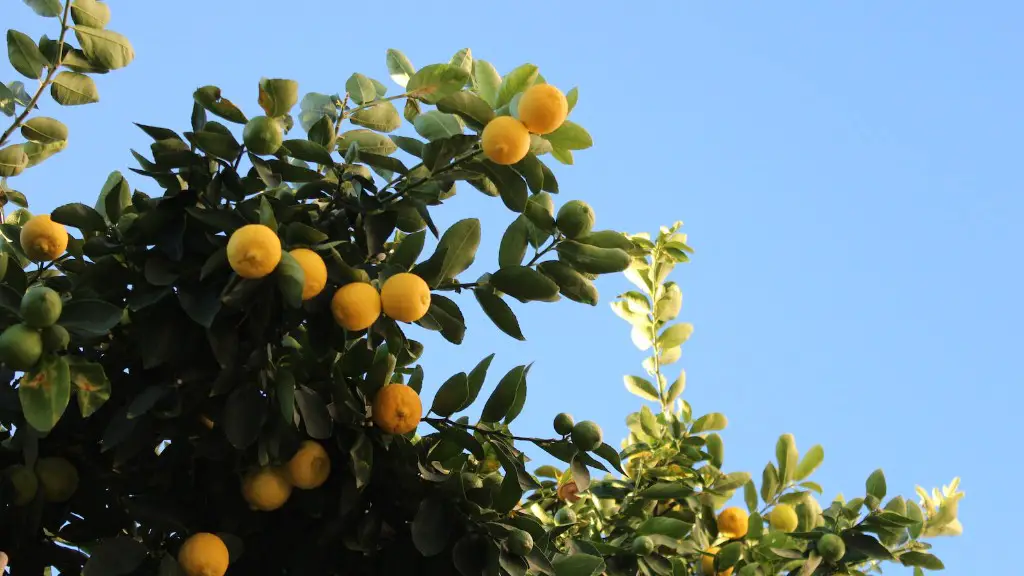Planting a lemon tree from a lemon is a rewarding experience and the perfect way to enjoy fresh lemons straight from your very own garden. The process is quite simple but requires special care and attention to ensure a healthy and fruitful yield. Here are the steps to successfully grow your own lemon tree.
Firstly, you will need to find a mature, seed-bearing lemon. The best thing to do is to ask around your local area for anyone with a lemon tree who would be willing to give away some of their lemons for you to use. This will save you from having to buy the fruits from a grocery store.
Once you have the lemon of your choice, the next step is to remove the seeds from the pulp. Soak the lemon in a bowl of fresh, warm water for an hour or so and then gently rub the pulp off the seeds. Then rinse the seeds off with the same water before transferring them to a different container.
After that, choose a container for the seeds. Since the seeds need good drainage, opt for a pot that has large drainage holes and fill it with a quality soil mix. Place the germinated seeds a few inches apart from each other, cover them with the soil, and water well.
Now the lemon tree is ready to be placed in its final location. Choose a spot in your garden that receives ample sunlight – lemons need around 6-8 hours of direct sunlight a day. It is best to plant the sapling in its permanent spot once it is a few feet tall.
If your area gets particularly cold during winter, make sure to provide some extra protection to the sapling. Mulch around the plant to keep the roots warm and/ or install a windbreak to shield the sapling from strong gusts.
Finally, make sure to water the tree regularly and fertilize it at least twice a year. Prune it gently and constantly keep an eye out for pests and diseases that might affect the growth or health of the lemon tree. With proper care, you will be able to enjoy the sweet fruit in no time!
Fertilizing a Lemon Tree
Maintaining an ideal nutrient balance is essential for the vitality and growth of a lemon tree. Fertilizing a lemon tree should be done at least twice a year, preferably once in the spring and once in the fall. While there are many different types of fertilizer on the market, the best option for a lemon tree is an 8-8-8 fertilizer. This type of fertilizer is made up of equal parts of nitrogen, phosphorus, and potassium, and is specially formulated for citrus plants.
When applying fertilizer, make sure to spread it evenly near the base of the tree and avoid pouring it too close to the trunk as this might damage the roots. Water the fertilizer thoroughly once applied and then do not fertilize again until the same time next year.
It is important to note that too much fertilizer can harm your tree and its fruits. Therefore, never fertilize more than twice a year, and follow the instructions on the packaging carefully.
Fertilizing is a great way to ensure the healthy and sustainable growth of a lemon tree. Regular fertilization is sure to increase the yield and quality of the fruits in your garden!
Caring for a Lemon Tree
Growing a lemon tree requires consistent and careful maintenance. Caring for a lemon tree means making sure it is receiving adequate sunlight, water, and nutrition to promote healthy and strong growth.
Firstly, the tree will need around 6-8 hours of direct sunlight a day. If your area gets particularly cold during winter, then make sure the tree has some additional protection by mulching the base and installing a windbreak to protect it from strong gusts.
Secondly, make sure the tree is getting enough water. While young trees need more frequent watering as they are establishing their root systems, mature trees will only need to be watered once or twice a week depending on local weather and soil conditions.
Thirdly, ensure the soil is properly nourished with fertilizer. As previously mentioned, 8-8-8 fertilizer should be applied at least twice a year, once in spring and once in fall. Make sure not to over-fertilize, as this can harm the tree.
Finally, regularly inspect the tree for pests and diseases. Early detection and treatment of infestations and illnesses is essential for maintaining a healthy tree. Check for symptoms like yellowing leaves, leaf curling and dropping, and small bumps on the branches and leaves.
Pruning a Lemon Tree
Pruning is an essential part of lemon tree maintenance and should be done regularly. Pruning helps to not only improve the shape and yield of the tree but also to maintain overall health.
Before pruning, make sure you have the right equipment. Gloves and cutting tools should be used to protect yourself and avoid damaging the tree. The best times to prune your lemon tree are during the spring and summer months, as long as the weather is warm and dry.
When pruning, use thinning techniques rather than topping. Thinning out will create better airflow around the tree, allowing it to receive more sunlight and air. Cut off any dead, damaged, or diseased branches, as well as any crossed and rubbed branches. Make sure any cuts are clean and at a 45-degree angle.
Finally, it is important to not cut off more than ⅓ of the branches at once. Thinning out the tree over two to four years is the best way to ensure long-term health and growth.
Harvesting Lemons From a Lemon Tree
One of the most exciting and rewarding parts of taking care of a lemon tree is harvesting the fruit. Harvesting usually begins a few months after the bloom period, once the fruit has gone from green to yellow.
Start off by selecting the heaviest and ripest fruit from the tree. If you have to twist the fruit in order to remove it, then the lemon is not ripe enough. Instead, use a pair of bypass pruners and trim off the stem at the point of attachment.
If the tree is larger, use a ladder and pick from the higher branches. Again, gently twist and remove the fruits that are already ripe and make sure to leave a few behind for future harvests.
Finally, check your lemons for any pests or insect damage and store them in a cool, dry place. Enjoy the fruits of your labor!
Preventing Diseases in Lemon Trees
In order to ensure the health and longevity of a lemon tree, it is important to prevent any diseases or infestations. Among the common diseases and pests affecting citrus plants are root rot, citrus ringspot, scale, and mealybugs.
Most of these infections can be prevented by proper care and maintenance. Make sure to water the tree regularly and fertilize it twice a year. Plant it in a sunny spot that is not too windy, and provide extra protection to the tree during the winter months if needed.
Inspect the tree frequently for signs of pests or illnesses. Yellowing leaves, leaf curling and dropping, and small bumps on the branches and leaves are all indicators of an infestation or disease. If any of these are present, take steps to immediately treat the tree as soon as possible.
By properly caring for a lemon tree and noticing any signs of diseases or pests early on, you can ensure the fruits you harvest are not only sweet and juicy but also healthy and safe.



